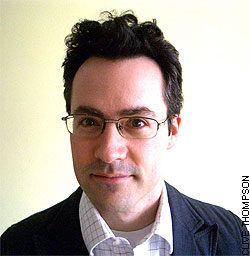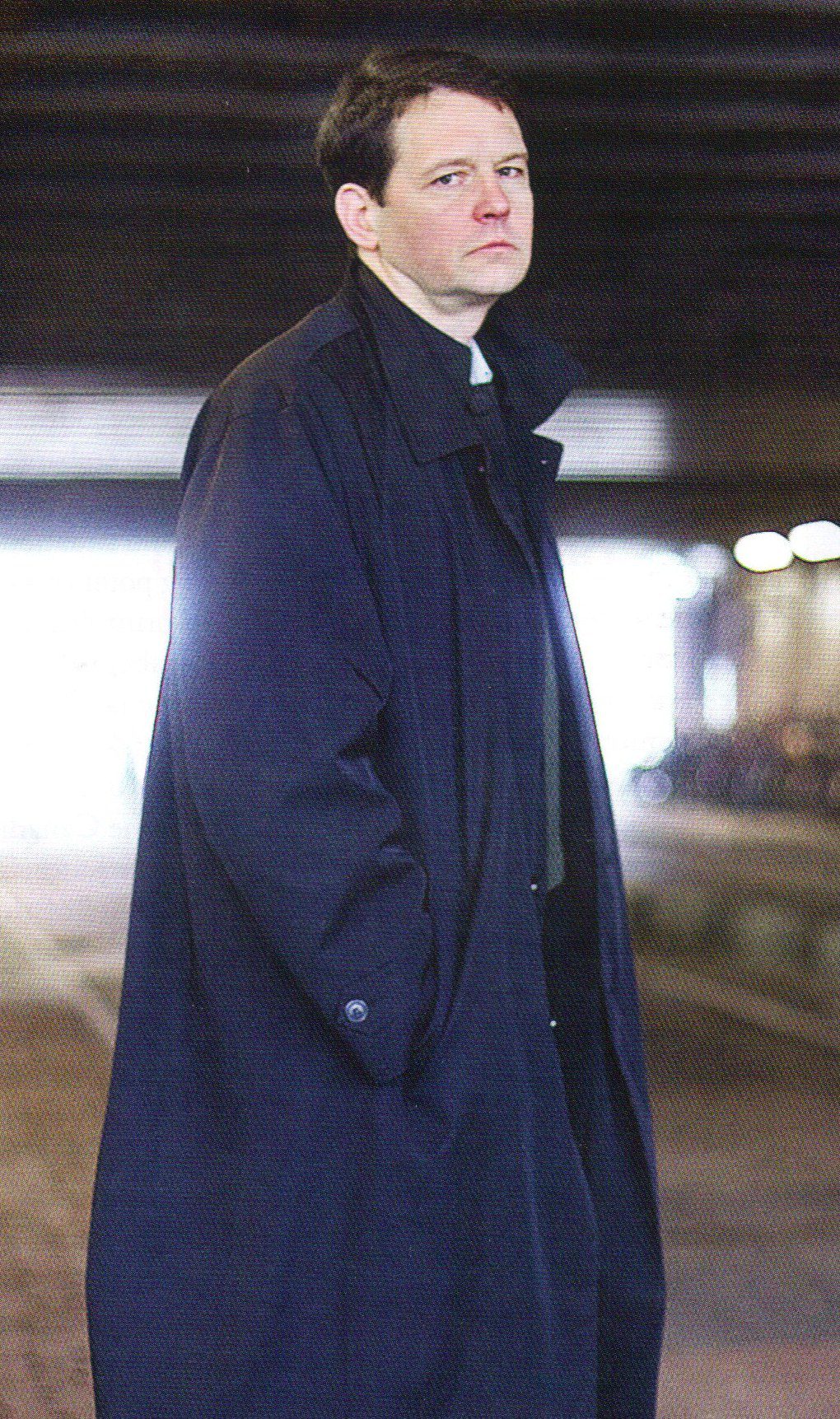What Makes Clive Run?
Clive Thompson talks fast, works fast, sleeps little and makes a flying leap from editing This Magazine in Toronto to writing cover stories for The New York Times Magazine
Sitting in an Internet café in the Czech Republic, Clive Thompson is frantically searching for lawyers in Spain who specialize in Internet law.
A week prior, in Britain, Thompson received news that a virus writer had been arrested in Spain. The only information he could find about the arrest was on a website written in Spanish – a language he doesn’t speak – which didn’t name the virus writer, his lawyer or the city in which the arrest had taken place.
En route by train from Britain to Belgium, Belgium to Germany, and Germany to the Czech Republic, Thompson contacted the Spanish police, who confirmed that a man had been arrested for writing and releasing a virus that infected 120,000 computers – but declined to release any names.
“So I’m figuring, okay, these lawyers probably know each other,” Thompson says, “and if I can just talk to one of them, he’ll probably know who the lawyer handling this case is, right? Because there’s going to be a finite number of lawyers who know enough about cyber law to be able to defend this guy.”
Thompson has only two days before he has to be in Austria. Even if he’s able to track the virus writer down for an interview, he’ll have to take a train up to Prague, catch a flight to Britain, then catch the next flight to Spain. And then he’ll have to figure out how to get to Austria in time for another interview with a virus writer who’ll turn out to be the lede of his story.
“There was a lot of hair-trigger timing with that story,” Thompson says, laughing, a year after it was published inThe New York Times Magazine, “but it all came together nicely.” He tracked down the lawyer and, halfway to Prague, received a text message on his mobile phone from the virus writer agreeing to the interview.
It’s hour number three of my interview with Thompson. In his West Village apartment in New York City, the 37-year-old freelancer is wearing dark jeans, a four-day growth of beard and a headset, so that he can walk around the apartment while he talks. Thompson, who grew up in North York, Ontario, is a regular contributor to the Times magazine, New York magazine and Wired. His most recent feature, about blogs, was the cover story for the February 20 issue of New York.
Like the Times magazine feature about virus writers, Thompson’s writing tends to fall along the intersection of politics, culture and technology. He’s written about artificial intelligence, neuromarketing and video game violence. And he loves wearing suits. “Some of us think it’s just an affectation,” says Greg Sewell, who was the best man at both of Thompson’s weddings. “Clive just thinks it looks better than any other format of men’s clothing.” His dogged work ethic has earned him the praise of his editors. Like few other Canadian-born journalists – Patrick Graham, Guy Lawson and Malcolm Gladwell – Thompson has made a name for himself in New York City. “He’s insanely successful,” says Sewell, “He’s not just getting by.” And he’s done it with style.
• • •
“So, who else have you talked to?” asks Thompson’s wife and fellow New York journalist Emily Nussbaum as she rocks their three-month-old baby. She guffaws when I mention Sewell. “He must have basically said that Clive is this fabulous person, very well-dressed, curses like a sailor,” she says. “Did he compare him to a Tarantino movie?” No, I tell her. “He once said that to me, that Clive is like a Tarantino movie.”
Sewell, who also lives in New York, has known Thompson since his University of Toronto days in the late 1980s, when they reported and edited for The Strand, a biweekly Victoria College newspaper, and The Varsity. It was where the two of them learned and fine-tuned their journalism skills.
Thompson has known since Grade 12 that he wanted to be a journalist. He wrote hundreds of articles for The Varsity and took a year off to serve as its news editor. One piece in particular he worked on, a profile about Ursula Franklin, a philosopher of the politics of science and technology, turned him onto what has become his life’s work. (His childhood spent programming games on a Commodore 64 and his self-described “geekiness” might also have contributed.) “I realized, oh my god, I could actually unify this technology stuff with my interests in politics,” he recalls, “and that’s essentially when I began to realize, this is something I think I’d like to do with my life. I’d like to write about science and technology and how they impact society.”
When he graduated from U of T in 1992, Thompson took a job as a receptionist at a driving school on Bloor Street for $8 an hour. Then he worked at the League of Canadian Poets for a year. He considered himself a good reporter, but had no connections in the industry and no one would hire him as a journalist. So he enrolled in Ryerson University’s two-year post-graduate journalism program. “Generally, I hated it,” recalls Thompson. “It was horrifying to have to go back over all this crap I already knew how to do.” He spent more time working with his classmates on a zine called Shapeshifter than on schoolwork. (In one issue, Clive wrote about the nutritional value of Pop-Tarts.) “We’d take them to bars we liked and dump a pile,” remembers former classmate Sean Stanleigh.
When one of his journalism instructors sat him down and told him that he’d never seen such a depressed and angry person, Thompson took that as advice to leave the program – but not before he’d landed a summer internship at The Globe and Mail. That same summer, in 1994, Thompson got a call from Naomi Klein, then editor of This Magazine. She’d edited The Varsity a couple of years before Thompson and knew him from activist groups he’d been involved with at U of T. She wanted him to write a feature about anti-racist action. The feature catapulted Thompson into freelancing after he left the Globe at the end of the summer.
“I thought, if I can just make $250 a month for rent and maybe $100 more for food, then I’ll be fine,” Thompson says about his first crack at freelancing in Toronto. He lived in “an absolute shithole” infested with cockroaches in Kensington Market with four other underemployed friends. When Klein left This Magazine a year later, he got the editorship.
The first issue Thompson edited was the second-worst selling issue in the history of This Magazine. The January 1996 cover story about legal corruption on a Native reserve from his second issue won a National Magazine Award. Then Thompson had the idea of running a technology issue. “At the time, the readers ofThis Magazine were really, really technophobic,” he says. “They were like, ‘Technology and robots are taking our jobs away. We have to fight this.'” The controversial issue ran stories about interactive pornography and digital cash. Though there was a lot of backlash, the May/June 1996 issue was Thompson’s favourite.
• • •
The first time Thompson’s wife remembers hearing of him in New York was at a job interview for Lingua Franca, a now-defunct New York magazine. “I walked in, and the editors at Lingua Franca, who I knew because I’d been writing for them, said, ‘We just met this crazy Canadian! He talked a mile a minute!'” Nussbaum remembers. “They were so flabbergasted by him.” Thompson, who had traveled into New York City for the interview, didn’t get the job. But he moved to the city shortly after with his first wife who was attending university there. Thompson has an equation that he uses to illustrate what moving to New York is like, financially: to live in New York and maintain the same standard of living as in Toronto, you must double your income and convert it into American dollars. Even then, you’ll only be living in a Brooklyn suburb. If you want to live in Manhattan, you must triple your income. “I was terrified of the move to New York,” says Thompson. “I was prepared for total failure at any time.” Although he wanted to freelance, Thompson considered looking for a full-time job. “I had these visions I was going to end up working for a magazine about the organizational infrastructure of the paper clip industry,” he says. “It only comes out once every quarter, and there’s two people who work for the magazine in some sub-carrel in the Time Warner building and I never see the light of day, and that’s essentially my journalism career.”
His first big New York feature was an article published in Lingua Franca in 2001 about a university professor who’d created a controversial “essay-grading machine,” a story that plunged Thompson into a study of linguistics. He worked full-time for two months on the story. “It didn’t make that much money, but I was like, I’m going to make this story absolutely rock,” Thompson says. “I’m going to just kill myself so that this thing is fantastic. I’m going to cover every base. I’m going to talk to every single person.”
In that year, Thompson, who was still freelancing for Canadian magazines, wrote two monthly columns, three features for Report on Business magazine, four features for the now-defunct Shift Magazine and two features for Lingua Franca. “And anyone who called me up and needed a 300-word brief written for some minor magazine,” he says, “I would do it.”
From there, Thompson’s career became a web of editors – “precipices of connections,” he calls them – who moved from smaller American magazines he was writing for to larger ones, editors who saw his writing in other magazines and a hell of a lot of hard work. Seven years after he arrived in New York City, Thompson got his first story in the Times magazine. By that time, he had a tremendous work ethic. “He seems to be able to write a lot more than most writers,” says Paul Tough, Thompson’s editor at the Times magazine. “Most of our writers only write for the Times magazine because we take up a lot of their time. Clive’s got enough energy that he can write for a couple of magazines at the same time. I’m always impressed by that.”
When his friends aren’t working on anything specific, Thompson urges them to freelance. “And our answer is always, ‘We’re not you, Clive,'” says Sewell.
Thompson stopped working for a couple of months when his son Gabriel was born, but now he’s back to juggling 16 features (3,000-8,000 words each) a year, a biweekly column for Wired News, a monthly column for Wired, a bimonthly column for the Times magazine Play and a few occasional guest columns. His home office, filled with old-fashioned typewriters, huge stacks of video games, origami and thousands of books, was converted into a nursery, so Thompson moves his laptop from sofa to sofa in his living room and rents a desk at a “cubicle farm” across town. He occasionally works out of Internet cafes.
“I’m actually delirious right now,” Thompson said when he answered the phone for one interview. He’d gone to sleep at 8 that morning, after working on a draft all night. He’d slept for three hours and woke up again to spend the rest of the day writing. He’d forgotten, when he scheduled the interview, that he’d made plans to meet up with a friend.
“I’m going to be up at 7 tomorrow morning,” he’d said, “You can call me anytime after that.”
When I call, Thompson launches into a story about an unemployed manic depressive, living in San Francisco, who’s built a machine that mimics human conversation so well that people can’t tell they’re not talking to a human being. “Clive has three million different interests that he’s extremely passionate about, knows a lot about, and can debate about,” Nussbaum says. “He’s genuinely not monomaniacal.”
Thompson even writes poetry. A slow-running computer became an excuse for writing a series of poems called “startup poems” – each composed on a typewriter while Thompson waited for his computer to reboot.
And one of the hardest reporting assignments he’s ever had was the first story he wrote for New Yorkmagazine about an art dealer who’d been running a forgery scam. The only information that the editors had was a clipping from a newspaper, and they wanted the article researched and written in two weeks. Thompson worked twenty-two hours a day on the story.
“When the story came out,” says Thompson, “the FBI called and said, ‘You actually hunted down people that we weren’t able to contact.'” He admits he drinks lots and lots of coffee.
For more Clive Thompson, check out his blog Collision Detection, or read some of his articles in our selected reading list below.
Selected reading list:
“Blogs to Riches,” New York Magazine, February 20, 2006.
“Meet the life hackers,” New York Times Magazine, October 16, 2005.
“The Other Turing Test,” Wired Magazine, July 2005.
“Cruel Intentions,” New York Magazine, February 7, 2005.
“The Xbox Auteurs,” New York Times Magazine, August 7, 2005.
“How to Make a Fake,” New York Magazine, May 31, 2004.
“A Really Open Election,” New York Times Magazine, May 30, 2004.
“The Honesty Virus,” New York Times Magazine, March 21, 2004.
“The Virus Underground,” New York Times Magazine, February 8, 2004.
“There’s a Sucker Born in Every Medial Prefrontal Cortex,” New York Times Magazine, October 26, 2003.
“Approximating Life,” New York Times Magazine, July 7, 2002.
“The Know-It-All Machine,” Lingua Franca, September 2001.
“Good Clean Fun,” Shift Magazine, December 1999.
Jacqueline Nunes was the Editor for the Summer 2006 issue of the Ryerson Review of Journalism.





![[Redacted]](../wp-content/uploads/2014/12/Screen-Shot-2014-12-03-at-11.13.02-AM-150x150.png)









































Great article about a great writer.
Clive is an amazing writer.
I’ve never read anything more informative and convincing than his piece on autonomous cars and the end of parking.